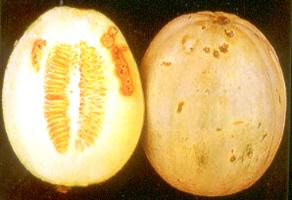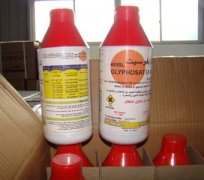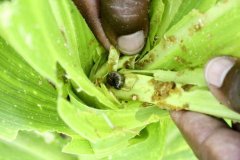What harm does bacterial fruit spot of cantaloupe and watermelon have? Control of bacterial Fruit spot in Watermelon
From 1992 to 1993, in the coastal area of Yunlin County and Shanhua area of Tainan County, it was sporadically found that the fruit surface of large watermelon showed irregular water immersion, slightly cracked disease spot, mainly occurred in the rainy season, the disease spot spread on the pericarp, and did not harm the pulp at the initial stage.
In May 1997, the muskmelon fruit in Ilan, Taiwan appeared on the surface like a melon fruit fly, the disease spot would not expand, and no insect body was found in the fruit, but the flesh was brown rot, which was proved to be caused by the same pathogenic bacteria as the bacterial fruit spot of watermelon. In the rainy season, in the high temperature and humid environment, the epidemic situation was also reported in Taitung and Hualien, and the injury rate of some watermelon fields in Taitung was nearly 20%. The small watermelon in the central Longjing area appeared diseased fruit that is different from the big watermelon and resembles the foreign cantaloupe. In August, the damaged fruit rate of the reticulated muskmelon cultivated in the open air of about 7 hectares in Jialixing, Tainan County reached 40%, and farmers suffered heavy losses. In April 1998, Dalin in Chiayi County, Xuejia in Tainan County and Nanzi in Kaohsiung County all reported that open-air cultivated muskmelon gardens were killed one after another. From May to June, muskmelon in Ilan was also injured again, and the injury rate was more serious than that of last year.
Pathogenic bacteria and symptoms
Pathogenic bacteria A. Oat subspecies citrulli (formerly Pseudomonas pseudoalcaligenes subsp.citrulli) belongs to Gram-negative bacilli, which can infect other crops such as Cucurbitaceae, tomato, pepper and eggplant by artificial inoculation except watermelon and muskmelon. The symptoms vary with host species and varieties. The typical symptoms on muskmelon fruit are small spots on the pericarp, dark brown or olive color, water-immersed halo ring or non-water-immersed halo ring, and most of the spots on the pericarp do not expand. however, the pathogenic bacteria have invaded the pulp tissue to cause water immersion, brown rot or cork symptoms. Some varieties showed irregular water-immersed plaques on the pericarp, and the pathological changes were only in the present pericarp at the initial stage of the disease, but the pathogenic bacteria also spread to the pulp in the middle and later stages. In addition to harming the fruit, cotyledons, leaves and stem vines can be harmed. The symptoms of this leaf are like dew fungus disease limited by the vein of the leaf, but it will spread along the vein of the leaf, soaked in dark brown water, and the milky white traces secreted by pathogenic bacteria can be seen on the disease spot in high humidity environment. Infect young leaves and the disease does not continue to spread, it will cause disease spot rupture, leaf deformation symptoms, harm to stem vines to form a water-immersed brown disease, gradually expand and wither. When the disease of leaf and stem is serious, in addition to affecting the plant growth, it will be the main source of infection that harms the fruit.
The disease spot of cantaloupe leaves shows the milky traces of pathogenic bacteria secreted by the disease spot.
The typical symptom of watermelon fruit is the upward epidermis of watermelon fruit, which first appears small water-immersed spots, and then gradually expands into irregular large olive water-immersed patches. At the initial stage of the disease, the lesion is limited to the pericarp, and the pulp tissue is still normal. However, it has seriously affected the commercial value of watermelon and cannot be stored. In the middle and later stage of the disease, the infected pericarp will also show the phenomenon of cracking. Pathogenic bacteria can spread to the pulp alone or with saprophytic microorganisms, resulting in pulp rot. After some varieties of fruits were infected, only cracked brown spots appeared on the pericarp, but there were no obvious olive water-immersed plaques, but the pathogenic bacteria had invaded the pulp tissue and caused serious water-immersion symptoms. After showing water-immersed spots on the watermelon cotyledons, the watermelon cotyledons turned into brown gangrene spots, often accompanied by a yellow halo ring, while the infected leaves formed small brown spots, which had little direct effect on the plant, but it was the main source of infection of the infected fruit. The bacterial fruit spot of balsam pear was found in "Gaoyue" and "Yuehua" in the fields of Taitung and Tainan. Citrulli, a subspecies of Oat.
Prevention and control countermeasures
The pathogenic bacteria will attach to the seed coat by collecting and washing the seeds, and it is also confirmed that the endosperm of the seeds will be contaminated. The transmission ability of the pathogenic bacteria has not been reduced after the seeds are stored at 12 ℃ for 12 months. After immersed in the pathogenic bacterial suspension, the pathogenic bacteria can only survive for 63 days after being stored at 12 ℃ for 12 months. And the residual capacity decreases with the increase of temperature. Seed-borne bacteria is the main route of transmission of the disease, naturally infected watermelon seeds have a high incidence after sowing. If the diseased fruit or plant remains are allowed to rot in the field, they can become an important source of the next crop, but how long the pathogenic bacteria can survive in other weeds or soil remains to be discussed.
Seeds treated with 50 ℃ warm soup, mixed watermelon juice and residue fermentation, dilute hydrochloric acid, sodium hypochlorite or calcium hypochlorite could reduce the susceptible rate of melon seedlings, but could not remove the pathogenic bacteria in the seeds. The experiment confirmed that muskmelon or watermelon seeds were impregnated with 1% hydrochloric acid for 20 minutes, washed with clean water for 20 minutes, and sowed after air-drying, which could reduce the incidence of disease. Top irrigation (head irrigation) and Rain Water are important ways for the spread of pathogenic bacteria in greenhouses and fields. Many watermelon or melon nurseries carry bacteria in their seeds, and sprinkler irrigation is used to feed water in the field area, resulting in 100% disease and heavy losses. Before the wax layer of the pericarp is completely covered, the pathogenic bacteria are easy to invade by the stomata, but because the stomata of the mature fruit are covered by the wax layer, the pathogenic bacteria can only be infected by the wound. In the inoculation experiment, it was found that the younger the fruit age of watermelon was, the higher the disease index was. When the muskmelon was inoculated with pathogenic bacteria in the female flower during pollination, disease spots could appear in the small fruit stage, so attention should be paid to the prevention and control before the small fruit stage. The chemical agents which can inhibit the growth of pathogenic bacteria were screened in the laboratory, and three kinds of seeds were selected for seed disinfection and field experiments. the results showed that after the seeds were inoculated with high concentration of pathogenic bacteria, the seeds were soaked with 81.3% Jiazi copper wettable powder and 10% tetracycline wettable powder to seed germination (25 ℃, about 24 hours), which could reduce the infection rate of melon seedlings.

- Prev

Roundup glyphosate herbicide charged with causing cancer US court awarded Monsanto $2 billion
On May 13, a court in San Francisco ordered German chemical and pharmaceutical giant Bayer to pay a couple $2.05 billion in compensation for using Monsanto's Roundup herbicide. Glyphosate (glyphosate) was diagnosed with cancer. This is the right time
- Next

What is an army bug in autumn? What are the prevention and control methods for the impact caused by military insects in autumn?
The autumn army insect is a kind of moth native to tropical and subtropical regions of America. It is recognized by the Food and Agriculture Organization of the United Nations (FAO) as an important agricultural pest in the world. This is also a common pest of corn. The larvae of autumn army insects eat many different crops, mainly.
Related
- Fuxing push coffee new agricultural production and marketing class: lack of small-scale processing plants
- Jujube rice field leisure farm deep ploughing Yilan for five years to create a space for organic food and play
- Nongyu Farm-A trial of organic papaya for brave women with advanced technology
- Four points for attention in the prevention and control of diseases and insect pests of edible fungi
- How to add nutrient solution to Edible Fungi
- Is there any good way to control edible fungus mites?
- Open Inoculation Technology of Edible Fungi
- Is there any clever way to use fertilizer for edible fungus in winter?
- What agents are used to kill the pathogens of edible fungi in the mushroom shed?
- Rapid drying of Edible Fungi

